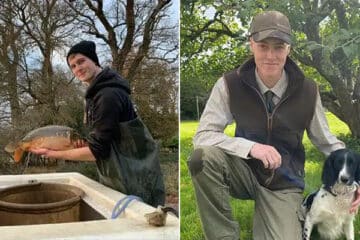Conservationists and landowners are celebrating another successful nesting season for ospreys in the Lake District.
Overseen by the British Association for Shooting and Conservation (BASC), local landowners and businesses, this season six osprey pairs have successfully bred 15 chicks.
All the osprey chicks have now been given an official British Trust for Ornithology (BTO) leg ring, so that they can be monitored for conservation reasons over the coming years.
Mike Thornley, BASC north regional officer and osprey project lead, said: “This season has been a complete success. As well as six nesting pairs rearing a total of 15 chicks, we have also had more immature ospreys in the area searching for future partners, including two pairs building nests which will hopefully lead to breeding successes next year.
“The Lake District has become a hub of activity for the osprey and through our outreach project, landowners and locals are revelling in the success.
“It will not be long until these young chicks begin their epic migration to West Africa for the first time. A journey they incredibly take on their own. We will be wishing them well and looking forward to their triumphal return in a few years.”
“For the next six weeks if you wish to see one of these magnificent birds why not pay a visit to Esthwaite Water Café, Hawkshead, near Ambleside. They offer osprey safari boat trips and have a large TV screen with a live stream of the nest.
One osprey continues to stand out from the crowd, and needs his own story telling.
The story of YC
The male YC was born in 2008 in Glaslyn, North Wales. He returned to the area in 2011 but was seen off by his parents, a natural behaviour in ospreys.
In 2013 his first nesting attempt with his mate was made on a pylon in South Cumbria, this was a practice nest as is usually undertaken by immature ospreys. This nest collapsed during the winter of 2013 and the power company funded a new platform on the adjacent Natural England nature reserve.
YC returned in 2014 with his mate and the new platform was an instant hit – they successfully raised two chicks.
YC and his mate returned to the platform in 2015 and produced three eggs but their breeding attempt failed. YC mysteriously disappeared whilst his mate was incubating the eggs. With no partner to fish for her, she had no choice but to abandon them.
Fortunately, on 30 March 2016 he returned going on to have one chick.
2017 was another successful year, producing one chick.
BASC started its osprey project in 2018, working in partnership with Natural England, and financed a camera to go on the nest site. YC was captured on the camera on 30 March and successfully reared three chicks.
Thanks to the BASC camera, in 2019 YC was seen arriving at the nest on 28 March. He went on to have a healthy brood of three chicks.
In 2020, YC arrived several days earlier than any of the previous years on 25 March. He again had a healthy brood of three chicks.
The first sighting of YC on the nest in 2021 was again on 25 March. He successfully reared two chicks.
Mike Thornley said: “YC has successfully produced a total of 15 chicks to date. At the age of 13 he is responsible for rebuilding a significant proportion of the UK’s osprey population and is a local hero in the Lakes.”
ENDS…
Notes to Editors:
Ospreys were extinct in the UK for much of the 20th Century. There are an estimated 40 pairs of ospreys in England and Wales, compared with around 300 pairs in Scotland. With six breeding pairs, the BASC project in the Lakes remains one of the largest and most successful breeding populations in England. Their return to the Lake District has been part of dedicated conservation effort by the British Association for Shooting and Conservation (BASC), Natural England, numerous other conservation bodies and landowners.
With a wingspan reaching 1.5m, they are among the largest birds of prey in the UK. They are also the only UK bird of prey that feeds exclusively on fish.

